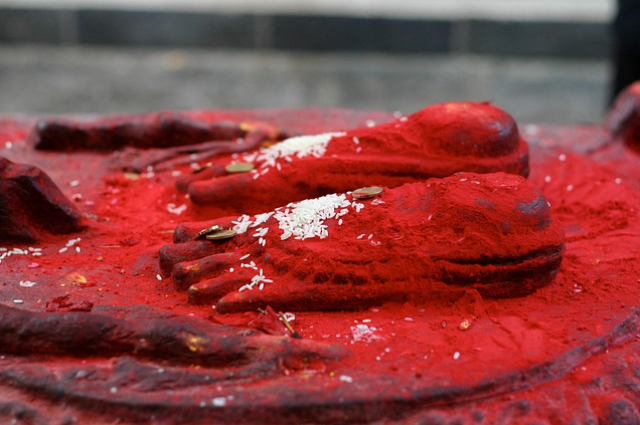
Scriptures like the Puranas reference animal sacrifices, which were practiced in India during the ancient Vedic Era. During this Kali Yuga, the Asvamedha horse sacrifice is prohibited per the Hindu text Brahma Vaivarta Purana. However, examples such as Ashvamedha and other Vedic-based rituals challenge the idea that animal sacrifice was limited to the ancient non-Vedic era. Animal sacrifices are recommended by the Itihasas, the Puranas (such as the Devi Bhagavata Purana and the Kalika Purana), and the Saiva and Sakta Agamas.
The Sanskrit word Bali, which means "tribute, offering, or oblation" in general ("vegetable oblations [... and] animal oblations,"), is used to refer to animal sacrifice. Among other things, Bali "refers to the blood of an animal"; among Hindus, it is also occasionally referred to as Jhatka Bali. Although the allusion to humans in Shakti theology is symbolic and carried out in effigy in modern times, the Kalika Purana makes a distinction between the ritual killing of goats and elephants, respectively, using the terms Bali (sacrifice) and mahabali (great sacrifice). In his commentary on the Karpuradistotram, for example, Sir John Woodroffe states that the sacrificial animals mentioned in verse 19 stand in for the six foes, with "man" standing for pride.
Man, horse, cattle, sheep, and goat were the five animals that might be sacrificed in Vedic India, according to the Brahmanic literature. Cattle sacrifice is one of the many sacrifices described in depth in the Rigveda and other Vedic texts. Vedic writings like the Yajurveda mention the Ashvamedha, a ritual where a horse was given free rein for a year before being sacrificed. The Ashwamedha is performed by Yudhishtra, the Chakravartin emperor in the epic Mahabharata, following his victory in the Kurukshetra war. However, an Ashvamedha performed by the Chedi king Uparichara Vasu is also described in the Mahabharata. The Ashvamedha was performed by the emperors of the Chola, Chalukya, and Gupta dynasties.
A goat had to be sacrificed to Agni and Soma before the day of the nectar offering to the gods, making Agnisomiya the most basic of all Soma sacrifices in which animal sacrifice was a significant component. Throughout the day of the Savaniya sacrifice, victims were presented to Agni. The animal was sacrificed in these rites as a symbol to the powers, not to be killed.
Krishna forbids animal sacrifices during the Kali Yuga, or the current era, in the Bhagavata Purana, which was composed during the sixth and eighth centuries CE. According to the Brahma Vaivarta Purana, animal sacrifices are forbidden during the Kali Yuga or Kali-varjya. Animal sacrifice during the Kali Yuga is likewise prohibited by the Adi Purana, Brihan-naradiya Purana, and Aditya Purana. All living things should be respected, according to the Padma Purana.
According to Sri Chandrasekharendra Saraswathi and other orthodox Hindu scripture interpretations, the Kali Yuga ban only applies to a select few kinds of animal sacrifices, most notably those involving cows and horses. According to these readings, Vedic animal sacrifice is justified because "the animal sacrificed attains an elevated state" and because it is "a little hurt caused in the cause of a great ideal." There are many exceptions in India, even though some contemporary Hindus refrain from animal sacrifice. Generally speaking, certain deities will find animal sacrifice desirable while others will not.
The offering of slaughtered animals is common and continues to be a "significant ritual in popular Hinduism," even though Hindu cuisine is typically vegetarian. The Eastern Indian states of Assam, Odisha, Jharkhand, West Bengal, and Tripura, as well as Nepal, all engage in animal sacrifice. Goats, poultry, pigeons, and male water buffaloes are killed as part of the sacrifice. For instance, during the three days of the Gadhimai festival, one of the biggest animal sacrifices takes place in Nepal. It was estimated that about 250,000 animals were sacrificed at the 2009 festival, which drew 5 million worshipers. The Nepali government outlawed the Gadhimai celebration in 2015.
Animal sacrifice is sacrificed to evil spirits, village goddesses like Shitala and Mariamman, Bhairava (Shiva's unbridled form), Narasimha (Vishnu's violent avatar), and furious incarnations of Hindu deities like Durga and Kali. The sacrifice is offered to appease these furious gods and win their forgiveness. Every year in the state of Odisha, during her annual Yatra/Jatra (festival) in the month of Aswina (September–October), animals such as goats and poultry are sacrificed before Kandhen Budhi, the ruling deity of Kantamal in Boudh district. Ghusuri Puja is the primary draw of the Kandhen Budhi Yatra. Every three years, a child pig, known as ghusuri, is offered as a sacrifice to the deity. Male goats are sacrificed to the goddess Samaleswari at her temple in Sambalpur, Odisha, during the Bali Jatra.
Animal sacrifice is an essential component of the ceremonial worship of the deities Samaleswari, Sureswari, and Khambeswari during the annual Bali Jatra of Sonepur in Odisha, India, which is held in the month of Aswina (September–October). Since the word "Bali" means "animal sacrifice," this yearly celebration is known as Bali Jatra. In the eastern Indian states, certain Durga puja ceremonies during Navratri include animal sacrifice. In this ceremony, a sacrificial animal is offered to the goddess in the hope that it will incite her to exact harsh retribution on the buffalo monster. Christopher Fuller claims that outside of the Shaktism tradition present in the eastern Indian regions of West Bengal and Odisha as well as the northeastern Indian provinces of Assam and Tripura, Hindus rarely perform animal sacrifices at Navratri or at other times. Furthermore, substantial animal sacrifices are observed during the festival season even in these states.
In certain Shakta Hindu groups, a symbolic sacrifice is offered instead of an animal sacrifice to commemorate the victory of Durga and the destruction of the buffalo demon.
On Navratri, the Rajputs worship their horses and weapons. In the past, they sacrificed a goat or male water buffalo to a goddess known as Kuldevi; in some places, this custom is still followed. The animal must be killed in a single blow as part of the rite. This ceremony was once thought of as a rite of passage into manhood and battle preparation. During the Rajput-Muslim battles, local stories trace the respect for the warrior-pativrata guardian goddess known as the Kuldevi. In Banaras, vegetarian offerings are offered to the Goddess in temples and homes, and the custom of animal sacrifice is not common.
In the Shaktism tradition, ritual offerings are presented to a Devi through animal sacrifice. Notably, it is conducted in front of local or clan deities in the Southern Indian states of Tamil Nadu, Karnataka, and Andhra Pradesh. Renuka is typically the goddess offered as a sacrifice in Karnataka. The animal is either a goat or a male buffalo.
Gujarat has prohibited animal sacrifice since 1971, whereas Tamil Nadu banned it in 1951 and repealed it in 2004. Rajput lords used to sacrifice buffalo, but they have since stopped doing so, and the gifts made to mother deities are now vegetarian. On the Indonesian island of Bali, some Hindus engage in animal sacrifice. Tabuh Rah is a Balinese Hinduism religion that involves animal sacrifice. One of its practices is a religious cockfight, in which a rooster is employed in a religious cockfight by letting him compete against another rooster. This is a spiritual appeasing exercise for Tabuh Rah. The ancient and intricate process described in the sacred Lontar texts is followed in ritual fights, and blood pouring is required as purification to satisfy the malevolent spirits.
